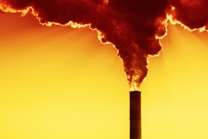Researchers push the boundary with high carbon emission scenarios

(PhysOrg.com) -- US and Swiss researchers have, for the first time, modelled a climate system with extremely high carbon emissions in an attempt to test the boundaries of the current computer simulation programs that inform us.
Published today in Environmental Research Letters, the study has revealed the potentially devastating effects that high carbon emissions could have on our climate.
Little attention has previously been paid to the upper bound range of future emissions which, as the researchers state, is imperative when testing the outcomes of climate change simulations.
The A1FI scenario, considered in the most recent report from the Intergovernmental Panel on Climate Change (IPCC), represents the upper bound of predicted carbon emissions.
The researchers, from the National Centre for Atmospheric Research, Colorado, and the Institute for Atmospheric and Climate Science, Zurich, created two hypothetical high carbon emission scenarios and compared their effects to the existing emission scenarios.
The first scenario created, CurrentMix, assumed that global energy behaviour would remain constant but that the global population would rise to 11 billion by 2100. The increase in carbon emissions envisaged in the A1FI scenario would be doubled by the end of the century.
The second scenario, AllCoal, was designed as a thought experiment to exceed all likely emissions for the remainder of the century.
This scenario assumed that the global population would increase to 15 billion by 2100 and that demand for fuel sources would increase, with more demand placed on coal – the fuel with the highest amount of carbon per unit of energy. This would result in four times the increase in carbon emissions envisaged in the A1FI scenario.
According to the researchers' computer simulations, the major differences between each scenario would begin to materialise towards the end of the 21st century.
By 2100, the AllCoal and CurrentMix scenarios would produce a warming of over 12 Kelvin (K) in the Arctic regions, with global sea levels rising by 33 cm and 27 cm respectively due to the thermal expansion of the oceans.
The A1FI scenario showed a 21 cm increase in sea levels; however the figures did not account for melting ice-sheets, which could increase sea levels by large amounts. The AllCoal scenario projected a complete loss of summer Arctic sea ice by 2070.
Each of the scenarios showed the typical pattern of increased rainfall towards the poles and drying subtropics. For example, the AllCoal scenario showed a 30-80 per cent precipitation reduction in Southern Europe, Central America, and Southern Australia as well as increases of 50-200 per cent in the Arctic and Antarctic regions, Northern Canada and Siberia.
The increase in most regions' maximum temperatures went up by a factor of two in the AllCoal scenario; however some regions showed a considerably larger increase. In particular, the maximum summer temperatures in Northern Europe increased by 6-7 K by 2100.
Lead author Dr Ben Sanderson said, "Our study considered a future in which fossil fuel availability is completely unrestricted and climate change is unmitigated, resulting in significant additional warming above the entire range of scenarios considered in the Fourth Assessment Report of the IPCC."
"This study showed us that the model behaves on a global scale largely as we would expect."
More information: "The response of the climate system to very high greenhouse gas emission scenarios" by Benjamin M Sanderson et al. Environ. Res. Lett. 6 034005 (2011): iopscience.iop.org/1748-9326/6/3/034005
Provided by Institute of Physics


















